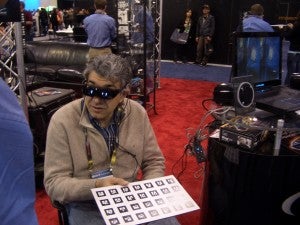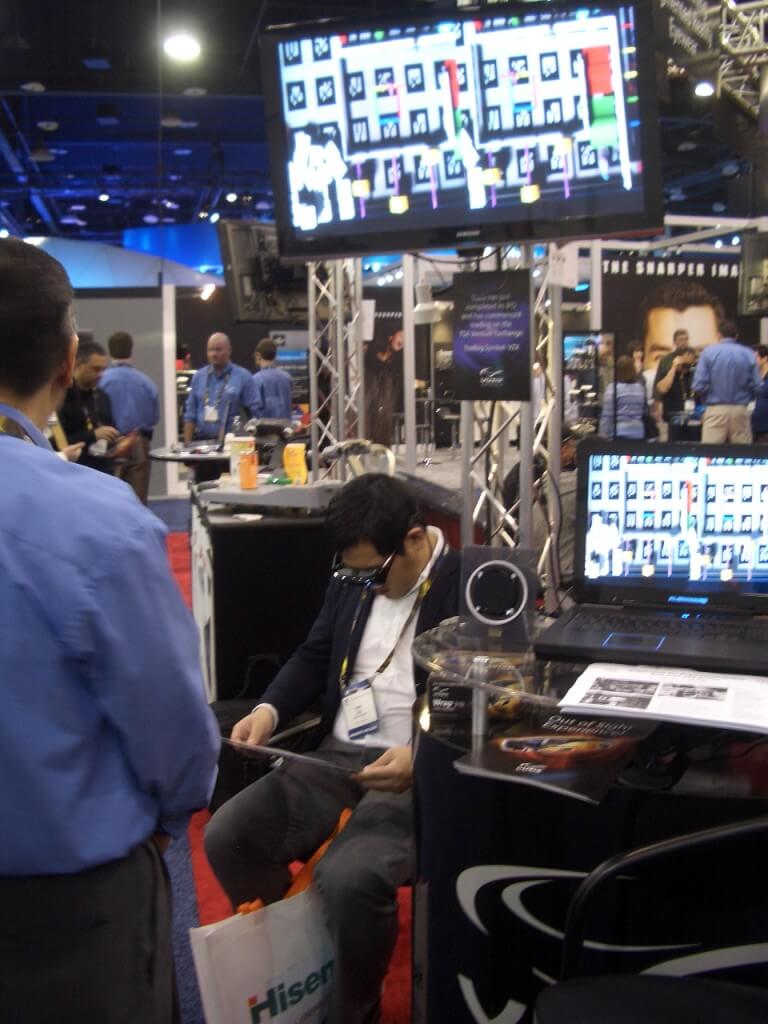
One of the really great parts of attending CES was getting to actually try out some of the cool new gadgets that are set to hit the market this year. Vuzix is offering the first retail version of stereo augmented reality goggles and they were definitely fun to wear. The Wrap920AR uses two 752×480 cameras and a 1504×480 (side by side) display to give you a clear view of the outside world as it is mixed with AR imagery. With six degree head tracking the Wrap920AR can provide realistic panning to the digital graphics, making the virtual and real worlds mesh very well. Reps at their CES booth said that the glasses will be available in the second quarter of 2010 for around $800. That could lead to some really amazing amateur and third-party development of AR later this year.
As simple as it sounds, the Wrap920AR impresses because it has two cameras, not one. With stereoscopic vision, digital images can be placed more accurately in the AR environment. Depth perception also allows the wearer to move through the real world and interact with moving objects without worry. As AR becomes more prevalent, it is likely that augmented reality systems will need to be worn for long periods of time and in changing environments.
Part of what makes augmented reality difficult to develop is that the hardware is almost always customized to each project. Researchers in the lab build their head mounted displays (HMD), or traditional cameras and monitor pairs, from scratch. This cuts down on the time they have to create new software, and it tends to generate digital worlds that work best in just one hardware system. Wrap920AR is relatively cheap (as are the other Vuzix AR systems and HMDs) and could lend developers a standardized platform with which they work quickly.

In order to showcase the Wrap920AR’s capabilities, Vuzix had Columbia grad student Ohan Oda on hand. Oda developed an AR game that realistically simulates gravity. The object of the game is to get a virtual marble to cross a finish line by tilting the real piece of cardboard it’s resting on. While the board is covered in AR markers (the black and white pixelated images) Oda says that only one has to be visible to the camera at any time to get the program to work.
I got to play Oda’s marble game, and while it wasn’t that impressive as entertainment, it did have some great implications for AR simulators. The marble, dice, and other objects on the board moved like real-world objects. With a haptics system, I could imagine the software being able to provide some truly life-like training for the military, emergency workers, etc. The tie-in with training isn’t that far of a stretch. Oda’s advisor is Steven Feiner, whose is also behind the use of AR to assist military mechanics.
Vuzix is still a relatively new company, it recently went public on the Toronto Stock Exchange (VZX), so it’s hard to know whether they have the marketing and business acumen to make the Wrap920AR a success. Certainly I think the world is ready for relatively inexpensive AR equipment (of which Vuzix has several packages) and the stereoscopic vision of the 920 really makes it stand out. Hopefully hardware like this will not only help Vuzix make it big, it will also fuel development of augmented reality. Every time I see a new use of AR I’m convinced that the technology is going to have an exciting impact on things to come. Hopefully I’ll have the chance to play with more AR gadgets as they arrive. Vuzix, you have my information.
[photo credit: Aaron Saenz]


